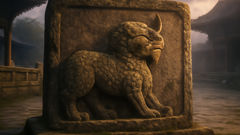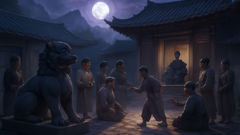Introduction
On the high ridges where mists held the morning like a secret, and in the courtyards of palaces where courtiers’ footsteps marked the hours, there is a story that moves between stone and breath — the story of the Haetae. In Korea the Haetae (often called Haechi) is not a mere monster of legend but a moral assay: a creature whose scales reflect not only the sun but the inlaid truth of human deeds. It is lion-like but stranger, its body rimed with overlapping scales like a fish or dragon, a single horn sometimes rising from its brow, watchdog and judge in one. For centuries, kings and magistrates, poets and potters, stone carvers and bricklayers invoked the Haetae as a guardian against fire, corruption, and chaos. They carved it at palace gates, placed stylized versions upon rooftops, and told children its tales to teach the difference between right and wrong. This introduction walks the line between geography and imagination — between the granite faces of real statues that stand today in Seoul and the mythic breath that animates them. It will describe the creature’s origin in oral memory, its symbolic qualities, and why an animal of myth came to be a civic emblem: because the Haetae could see what humans too often wished to hide. It intervened when words failed, opened the cracks in clever lies with a single unblinking judgment. As you read, imagine cold stone warmed by sunrise, the metallic scent of a city waking, the hush of a shrine where incense curls like a question. The Haetae is at once a protector against conflagration and a myth-maker’s mirror: justice embodied in scales. This retelling stitches together old stories, lesser-known tales, and contemporary reflections, offering a long view across seasons of belief that shaped how communities in Korea understood law, order, and moral consequence. It is a cultural map — not dry and scholarly but alive, taking you past temple steps and market stalls, through the whisper of palace corridors where haetae statues stood watch, to modern plazas where their likeness presides over justice in bronze and stone. By the time the narrative turns to specific stories, you will have met the Haetae as an idea as much as a beast: a moral engine that protects against both flame and fraudulent hearts, that distinguishes right from wrong with a clarity that humans often lack, and that endures because communities needed an image to rally their ideals around. The tale that follows is both old and freshly told: detailed, atmospheric, and intended to restore the Haetae to its rightful place in the imagination as more than ornament — as a living symbol of communal conscience.
Origins and Symbols: The Haetae in Myth and Memory
The Haetae’s origins unfold across oral traditions, temple carvings, and the steady hands of artisans who shaped stone and ceramic for generations. Early stories place its first breaths in the shadowed folds of mountains where shamans and elders read omens in wind and water. One strand of myth suggests the Haetae is a distant cousin of the dragon and the qilin: part lion in posture, part fish in scaled skin, and sometimes crowned with a single horn that slices the air like a verdict. These elements are not accidental. A horn is a line drawn between indulgence and restraint; scales are a ledger, counting deeds rather than days. The Haetae’s visage was shaped to be intelligible: an animal both fierce and fair, ready to stop a blaze and ready to stop a bribe. Where dragons embodied imperial breadth and qilin auspiciousness, the Haetae took on something more civic and precise. It was the public scribe of moral balance. Carved at the corners of palaces, on the eaves of governmental halls, and at city thresholds, the Haetae appears most often as a sentinel. The Joseon dynasty, with its devoted emphasis on legalism and Confucian morality, found a fitting symbol in the Haetae — an emblem that could stand outside the palace and remind both ruler and subject that justice must be visible. The creature’s association with preventing fire might seem mundane next to its moral role, but it is deeply connected. Fire, in many traditional societies, was both sustenance and annihilator; to control it was to control danger that could upend communal order. If the Haetae kept flames from consuming a palace or market, it also kept the potential for ruin at bay: ruin that often followed from greed, misrule, or negligence. In folk tales, the Haetae’s senses were uncanny; it could sniff out falsehood as if lies carried a scent. When a corrupt official attempted to pass a girl off as noble for his own gain, or when merchants conspired to cheat farmers on grain measure, the Haetae would tilt its head, a low rumble moving along its throat. Sometimes stories depict it as acting directly — a sudden gust that puts a lantern out, a stone that splits beneath a counterfeit-ready hand — or indirectly, inspiring a whistle that alerts a magistrate to a wrongdoing. Beyond concrete tales are the rituals and crafts that kept the Haetae present in daily life. Potters fashioned small haetae figures, roof-tile makers cast stylized heads along eaves, and court painters included the beast in scrolls that illustrated moral parables. In the markets, a merchant might press a tiny haetae amulet into a child’s palm with a caution: "Carry this and be honest," and parents taught their children about the sharp gaze of the beast. Its scales were described in minute detail by artisans: overlapping plates like river stones, hammered edges catching light in a way that made them appear both armor and scripture. This visual vocabulary reinforced the creature’s moral role: scales record and balance. The fabric of society needed a symbol that could be read by both peasant and prince. The Haetae fit because it addressed common anxieties — fire and fraud — without invoking a remote celestial bureaucracy. It spoke to the here-and-now of civic life. Symbolically, the Haetae’s horn and scales also map onto broader cosmological beliefs. In many tales, the beast is connected to heavenly mandate in miniature: where rulers claimed the right to govern through virtue, the Haetae supplied the visible counterweight — a reminder that virtue must be defended by the community. Local myths sometimes tell of a Haetae choosing to sit in a village square, remaining motionless for decades. In these stories, crops grow and disputes fade into reason under its watch. When such a beast finally rises and walks away, it leaves behind a changed people: one that has learned to judge itself more carefully. The Haetae’s presence in architecture is also instructive. At palace gates the statues were not mere decoration; their positions corresponded to cardinal directions, auspicious alignments, and the logic of feng shui as practiced in Korea. Their faces were intentionally watchful, their paws poised on stone, as if to say: "We are keeping accounts here." In written records and later histories, scholars attempted to catalog the Haetae’s functions. Some described it as a fire-ward, a protector of palaces and granaries. Others emphasized its moral agency: a creature that would punish false testimony in court by causing the guilty’s ink to run or their signature to collapse into smudge. These accounts, whether literal or allegorical, reveal a central truth: the Haetae’s power lies as much in its public claim as in any purported supernatural action. Communities adopted the beast as a civically binding image — a shared signpost pointing toward honesty, restraint, and social harmony. As the centuries turned, the Haetae’s iconography migrated from temple grounds to stone markers in villages and, later, into the modern city where municipal seals and sculptures would recall its protective function. Today, visitors to Seoul might find haetae statues reimagined in bronze outside government buildings, the animal transformed into a civic mascot that still carries the old demand: that those who govern and those who live under governance be held to a common standard of fairness. Within this long cultural arc, individual tales give shape to the abstract idea of justice. A magistrate saved by a Haetae’s intervention, a house spared from fire when a passerby notices a tile misaligned like a watchful eye, a merchant who returns ill-gotten gain after a strange dream of a scaled beast — such stories thread the Haetae into the everyday moral imagination. They are not merely entertainment; they are tools through which societies teach and reinforce codes of conduct. The Haetae, then, belongs to the language of civic virtue: a storied creature whose image keeps time with the rhythm of communal conscience.

Tales of Justice: The Haetae’s Judgments and Human Hearts
The Haetae’s stories often take the form of parable and episode, where a single judgment unfolds into broad moral instruction. One enduring tale tells of a mountain village that suddenly found its granary short each winter. The elders argued and suspected one another; tempers flamed and neighbors kept tighter watch. One night a child, restless and curious, followed a faint light to the granary yard and found a strange creature — a haetae, smaller than those carved at palaces but still scaled and stern — sitting beneath the eaves. The beast watched the child with eyes like polished obsidian. The next dawn, villagers found seed scattered at the yard’s edge and footprints leading to a neighbor who had recently fallen into disrepair. Confronted, the man broke down: pride had driven him to steal to keep his family from shame. The Haetae’s presence did not bring immediate punishment; instead, it supplied irrefutable evidence and initiated a community reckoning that worked toward restitution rather than simple retribution. This tale emphasizes a crucial feature of Haetae stories: the creature often functions to make the truth visible, forcing society to repair the wrong through communal processes. Another story centers on fire, an elemental danger the Haetae was believed to hold at bay. In a coastal town, a thatched roof caught flame during a storm when sailors brought ale and laughter into a house of the dead. The storm blew lanterns like fallen stars and the air carried sparks into rafters. As people scrambled, they saw a scaled silhouette stand at the ridgepole of a neighboring roof; its shadow on the lashing rain seemed to press the flames back as if by will. The blaze stuttered and then died. In the morning, the people found soot where the flames had been closest but no house burned to cinders. They placed offerings to the Haetae and vowed to rebuild with better care. Here the Haetae’s role is practical — protector of the household against calamity — but it is also didactic, reminding the community to balance revelry with responsibility. Several judicial legends position the Haetae as a supernatural witness in disputes. In one dramatic account, two merchants brought rival claims to a magistrate: both swore to the same deed, and documents were forged with equal care. The magistrate, desperate to determine the truth, arranged for both men to write their signatures upon a cloth placed before an image of the Haetae. The legend says the creature’s breath — or some subtle breath of wind through a shrine lantern — caused one signature to smudge and smear, revealing an imperfect forgery. The magistrate, guided by the sign, found the forger through questions and cross-examination, ultimately restoring honest trade to the market. These tales underscore how the Haetae was imagined in an adjudicatory context: its presence could tip the scales where human processes faltered. In moral narratives the Haetae often faced tests of its own judgement. One story tells of an emperor tempted to execute a nobleman for refusing to provide a bribe. The nobleman, stoic and impoverished, maintained his innocence, while courtiers bent toward richness and expedience. The emperor, uneasy, dreamt of a Haetae that would not let him rest; in the dream the beast stepped into the hall and planted a single stone under the nobleman’s cross-legged feet. When the emperor awoke, he realized how his mind had been clouded by temptation. He reversed the decree and instituted a policy to inspect records more carefully. Such narratives present the Haetae less as a punisher and more as a conscience — a mirror that returns a leader’s inner distortions into visible form. The Haetae could also be merciful. A beloved tale tells of an old woman renowned in her village for keeping a strict but kind watch over the roads. She took in travelers, mended shoes, and kept the village ledger. One year, drought shrank the rice harvest and a young man, desperate and ashamed, stole a bowl from her pantry to feed his mother. Caught, he expected swift punishment. But the Haetae, which had watched the woman’s kindness for decades, nudged the magistrate’s heart toward mercy. The community devised a solution where the young man worked to restore what he had taken over time and was taught a trade. The Haetae’s judgment here is restorative rather than purely punitive; it weighs intent alongside action. In visual arts and theater, Haetae stories play with ambiguity. In masked dramas the beast might appear as a chorus voice, its lines spoken by an actor while the physical statue remains part of the set. Painters used light to make scales shimmer, offering viewers a tactile sense of accountability. Potters shaped small Haetae figurines with tiny, inscrutable smiles; they could be displayed to warn against neighborhood mischief or given as charms to young merchants. All of these practices point to a cultural flexibility: the Haetae could be terrifying in one tale and tender in another, depending on what the community needed to learn. As Korea modernized, Haetae imagery adapted but did not disappear. In the late 19th and early 20th centuries, when cities reconfigured and the structures of government shifted under external pressures, the Haetae’s visual language migrated to municipal seals and public sculptures. One famous modern interpretation stands outside a civic center, engraved in bronze with a look that is less ferocious and more civic-minded. Children gather at its feet during festivals, and officials cite it in speeches about transparency and public welfare. When a scandal erupts, reporters might invoke the Haetae in headlines — a single-word reminder that accountability remains a citizen’s demand. Modern tales often place the Haetae in media-savvy scenarios: a whistleblower who finds a small haetae amulet hidden in a file drawer, a neighborhood campaign that uses the beast’s image to promote fire safety, or a school lesson where children role-play magistrates judging petty disputes with a cardboard Haetae on the mayor’s desk. These stories show that mythic figures can evolve into civic metaphors that anchor contemporary ethics. They are not simply nostalgic throwbacks; they are active elements of cultural pedagogy, helping communities imagine justice as something both attainable and watchable. The Haetae, then, lives as an ethical apparatus: not a replacement for courts or statutes, but a persistent cultural memory that reminds people of the ideal of visible, communal justice — the kind that checks power and protects the vulnerable. In a world of mutable institutions, the image of a scaled beast keeping flame and fraud at bay offers a steady point of reference, a reminder that some values are worth carving into stone and carrying forward.

Conclusion
Across centuries the Haetae has served many functions: ward against fire, moral arbiter in tales, architectural guardian of palaces and public spaces, and modern emblem of civic virtue. Its enduring power comes not from a single miraculous act but from the ways communities used the image to structure expectations of behavior: to teach children that truth matters, to remind officials that their power carries responsibility, to compel neighbors to care for one another against common dangers. The animal’s scales — often the most striking visual detail — function as a metaphorical ledger: each plate an entry, each reflection a small accounting of action and consequence. When people place a Haetae at a gate or in a public square, they are inserting a cultural promise into the landscape: that someone or something will remember what was done in the public light. In contemporary Korea the Haetae is visible in refurbished statues, municipal icons, and popular media. It has become a subject of scholarly interest, a motif for artistic reinterpretation, and a rallying image when communities seek to reaffirm honesty and transparency. Yet even as it adapts, the Haetae retains a simple, human lesson: that justice is not abstracted; it is practiced in kitchens and markets, courts and palaces, in the small acts where citizens choose to be fair or not. The myth therefore persists because it works as cultural technology — a narrative device that keeps the social ledger open and readable. To invoke a Haetae is to call for a collective remembering, a cultural nudge toward accountability. Whether one believes in the literal beasts of old or only sees them as stone and bronze, the story matters because it continues to shape behavior and expectations. In that sense, the Haetae’s greatest miracle is not an escape from harm but a slow and steady education in how to live with others. Its scaled silhouette against the skyline is a reminder: justice, like architecture, requires maintenance; it needs watchful forms around it and constant attention within. If we accept that myths are tools for organizing social life, the Haetae stands out as an especially practical one — fierce where it must be, merciful where mercy repairs, and always present as a civic mirror. By keeping its image at thresholds and in public memory, societies have a prompt to practice fairness and protection, not only for the powerful but for the common hearths that sustain daily life. The beast of scales asks less for worship than for vigilance, and perhaps for that reason it remains among the most resonant and useful of Korea’s many enduring myths.













